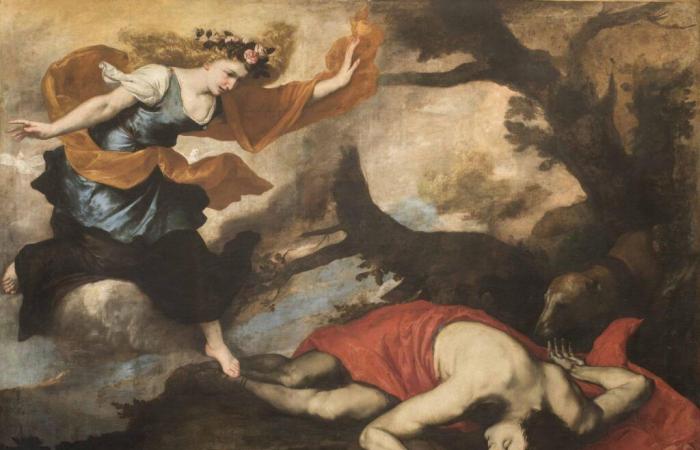There is a dark legend attached to Jusepe de Ribera. In 1621, his contemporary Giulio Mancini already saw him as a “follower” by Caravaggio “darker and fiercer”. Over the centuries, the image of an artist who took pleasure in scenes of martyrdom and “horrible and raw things like the bodies of old people” (sic), has continued to be peddled by critics, until Théophile Gautier saluting “a fury of the brush, a savagery of the touch, an inebriation of blood of which we have no idea”. In 1987, the very serious Larousse of painting still described the painter as“relentless inquisitor of human deformities”. Has the time come to review this judgment?
A world first
Discovering the retrospective “Jusepe de Ribera” at the Petit Palais in Paris, a completely different feeling emerges: the artist’s deep empathy for his most humble or vulnerable human brothers. For a long time most of his youthful work had been given to a mysterious master of Solomon’s judgment. And then, in 2002, the art historian Gianni Papi returned it to our “Espagnet”, who arrived in Rome at the age of 15. Ardently concocted by Annick Lemoine, director of the Petit Palais, this exhibition is the first to bring together these brilliant beginnings with the dazzling developments of the painter’s career in Naples, from 1616 until his death in 1652. However, this panoramic vision changes our perception of the work, revealing the audacity and brilliance of an artist in constant evolution, but also his contagious sensitivity.
See this beggar, holding out his beret in the first room, his eyes modestly lowered! By painting this man in rags, emerging from the shadows, his face and hands caressed by a ray of light, the young Ribera shows that he has assimilated the lessons of Caravaggio whose patrons he will seduce (Cardinal Scipione Borghese acquired this canvas). In reality, he is the first in Rome to dare to paint such a portrait of beggars, on a large format. Did he remember his own humble origins, the son of a shoemaker?
His gaze full of compassion is found, twenty years later, in a stunning painting, commissioned by the Viceroy of Naples: the portrait of Maddalena Ventura, known as The bearded woman. Depicted in full length, breastfeeding her child, she stares at us with a dignity which seems to discourage all sniggers in advance. The Clubfoot du Louvre does nothing else, parading against a background of blue sky, his crutch on his shoulder, and smiling at us despite his handicap! An “inclusive” painter before his time, Ribera here invites the viewer to charity, faithful to the message of the Counter-Reformation.
Drawings of tortured people
Sometimes fumbling at first, his compositions with several characters gradually become clearer in friezes or powerful diagonals, the eloquence of the gestures is exacerbated. Far from any idealization, the Spaniard attaches himself to real models, such as this old toothless slave that we recognize here in Philosopherthere as the executioner of Christ, elsewhere in Saint Barthélemy. Ribera loves worn-out bodies which he elevates to the dignity of ancient sages or apostles. With assumed verism, he paints Saint Jerome with flabby, wrinkled flesh, a symbol of human finitude awakened by the promise of Salvation, in the guise of an angel with a trumpet. By sometimes signing on a skull, the artist includes himself in these meditations…
Irresistible concentrates of tears and sweetness, three Pietàs, with Christ radiating against a background of darkness, reflect, at the heart of the exhibition, the absolute mastery of the Neapolitan years. Other scenes of martyrdom will follow, with moiré colors borrowed from the art of Venice and almost mannerist contortions. A series of very crude drawings shows how Ribera was inspired by the executions and tortures, exhibited at the time in public places by the Spanish power and the Inquisition which reigned over Naples. Upon his arrival in this city, the artist would not have hesitated to paint this Saint Barthélemyon the arm already flayed by the executioner and hanging it near the royal palace during a party, attracting public success and the purchase of the painting by the viceroy.
Joseph of Ribera, Saint Jerome penitent, 1634. Oil on canvas, 126×78 cm. / Museo Nacional Thyssen-Bornemysza, Madrid
His brushwork, however, seems less bloody than that of Caravaggio, for example, in David holding the head of Goliath, whose neck (severed) is veiled in shadow. Above all, Ribera seems to constantly summon our pity, like this dog about to lick the hand of his dying master, the handsome Adonis. It is brilliant in the final rotunda which brings together five spectacular martyrs, some of whom seem to literally fall out of the canvas. As if the painter was preparing to collect them in his arms.
“Ribera, darkness and light”exhibition including The Cross is a partner, is held at the Petit Palais until February 23, 2025. Catalog under the direction of. by Annick Lemoine and Maïté Metz, Ed. Paris Musées (304 p., €49).






